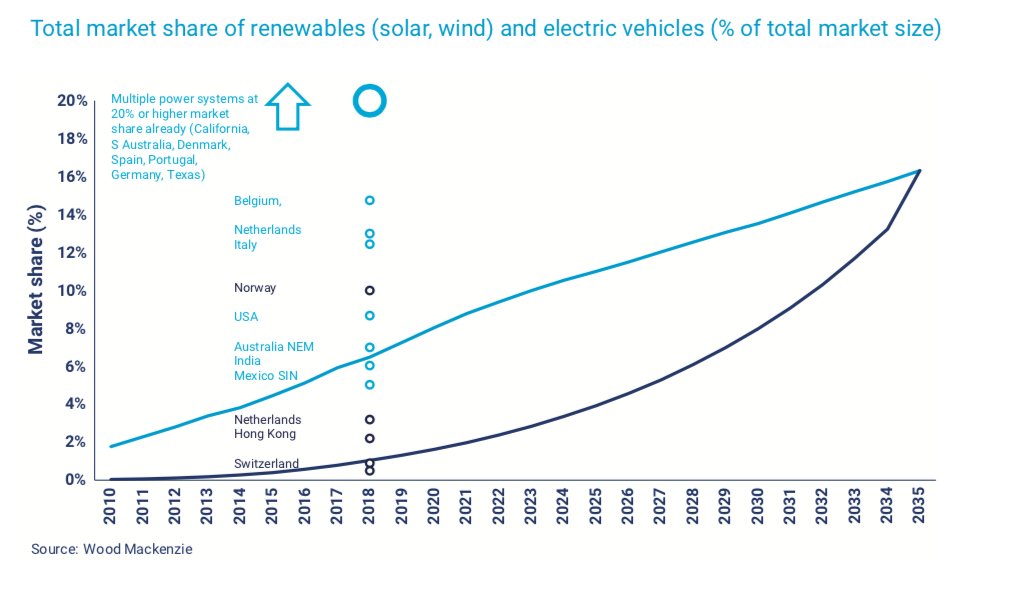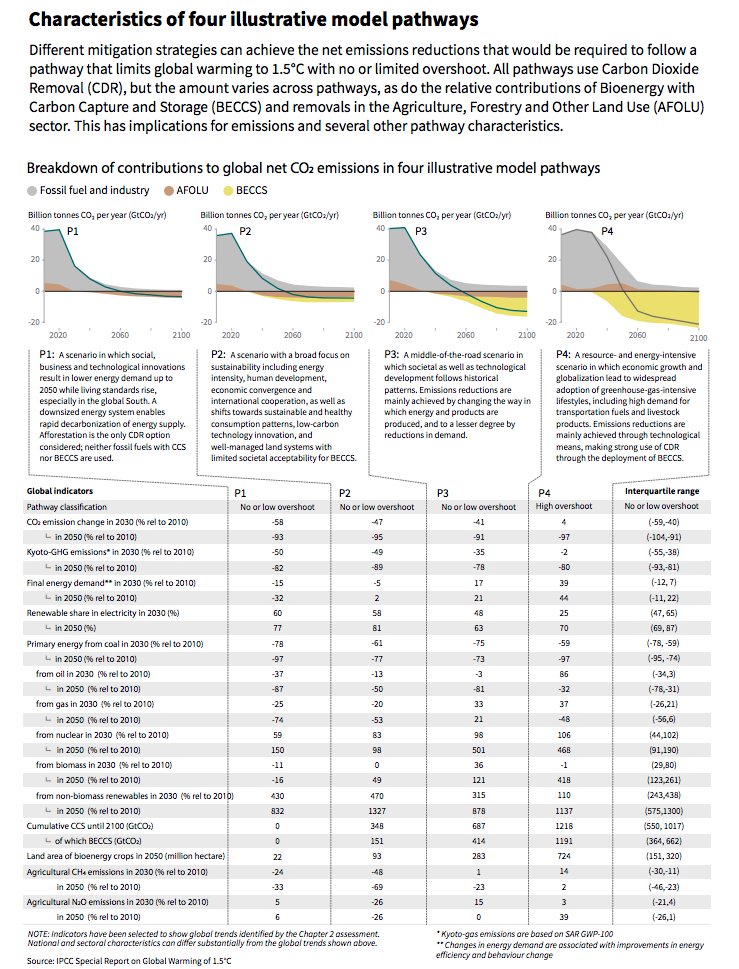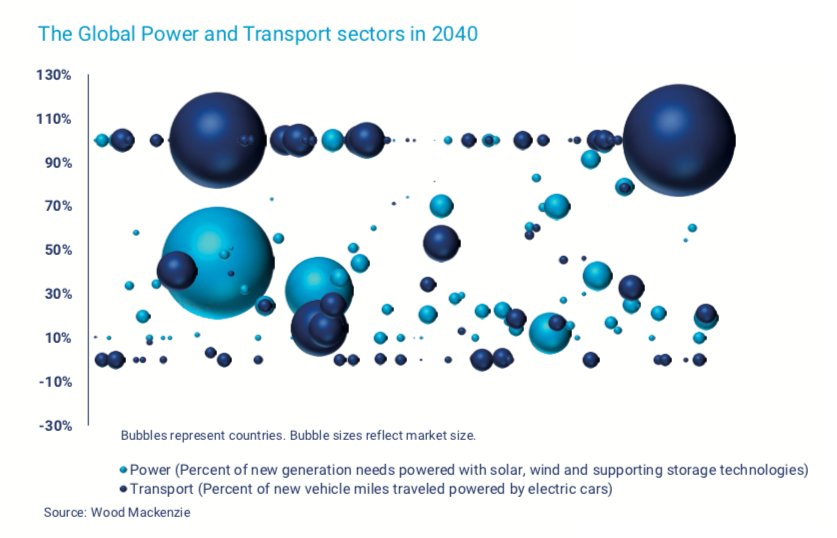The world only has 12 years to figure out how to keep temperatures from rising less than 1.5°C.
What happens if we creep toward changes of 2°C? Tens of millions more people will live in water-stressed regions; plant species would be twice as likely to decline; and corals would almost completely die out.
That’s the topline takeaway from a report published last week by the United Nations Intergovernmental Panel on Climate Change to assess how the globe can avoid catastrophic warming.
The report’s authors, all 91 of them, analyzed various scenarios that would avoid the worst impacts of a warming world. The "mid-range" pathways require renewables to provide 70 to 85 percent of electricity by 2050.
The reality today is very different. Solar and wind now make up 7 percent of the global power market, according to Wood Mackenzie. Overall, the world lags significantly behind the goals set out by the study’s authors. Meeting them, according to a co-chair of one of the IPCC’s working groups, “would require unprecedented changes.”

A new report from Wood Mackenzie finds “the point of singularity” — the moment when renewable electricity outpaces oil and gas — won’t happen until 2035. Based on the findings in the IPCC report, that’s five years too late to achieve drastic and necessary changes. WoodMac also notes, though, that the inflection point could arrive earlier due to “tectonic shifts” in battery technologies or distributed energy business models.
In other words, the globe is facing a historic energy transition in speed and scope — and it's still not enough.
“We’re very far from 70 to 85 percent,” said Dan Shreve, WoodMac’s head of global wind energy research. “I think we’re a long way off, quite frankly. We’re going to have a tremendous amount of difficulty achieving that 2050 goal.”
“Society needs to decide”
The IPCC report calls for serious changes throughout the entire global economy in order to draw down carbon dioxide emissions by 45 percent by 2030 and to zero by mid-century. To get there, the IPCC authors investigated about 90 pathways; 50 had little or no overshoot of the 1.5°C target.
The pathways that limit warming to 1.5°C increased the share of electricity from renewables by between 36 and 97 percent, supported by numerous technological innovations to make that penetration possible. At the same time, authors suggest coal would need to be phased out quickly while oil and gas would decline a bit less rapidly. Nuclear plays a decarbonization role in some regions, but authors note renewables out-compete it in most cases.

“Basically, we’re talking about deep, systemic, far-reaching changes,” said Debora Ley, an author of the IPCC report based in Guatemala and a member of the scientific council at Latinoamérica Renovable, a group that promotes clean energy in Latin America.
But numbers from WoodMac suggest the shift IPCC proposes represents a challenge that’s difficult to fathom. Shreve calls IPCC’s goals “extremely ambitious.”
According to WoodMac's analysis, once new technologies reach 15 to 20 percent of market share within the next two decades, the global energy “transition will be complete.” That's because wind, solar and electric cars will be "default" technologies. But it's really just the start. That still leaves a big gap to bridge in the years until 2050 if the world is to meet the transition called for in the IPCC report.
According to the IPCC, reaching its targets would require doubling investments in low-carbon energy technologies and energy efficiency in the coming two decades, and dropping investment in fossil fuels by about 25 percent.
The IPCC authors also considered how a climate-changed world impacts output from renewable energy technologies. As climate change advances, changing weather patterns will shift the amount of sun hitting solar panels or the wind turning turbines. Ley points to Costa Rica as an example. While the island relies heavily on clean hydroelectricity, rare dry periods mean fossil fuels must fill in.
“If you start thinking about the challenges that are inherent with those higher levels of penetration from a grid resiliency standpoint, there’s a tremendous amount of change that needs to occur both from a regulatory standpoint as well as a technology standpoint,” said Shreve.
Ley said it’s up to society to determine how to implement what the IPCC laid out.
“It is geophysically possible and…it is technologically possible,” she said. “The IPCC provides evidence about impacts and requirements for a warming of 1.5°C. Society needs to decide what to do with this information.”
Examining “massive changes”
Shreve said reaching even the mid-range of the IPCC’s recommendations, 70 to 85 percent renewables, will require radical transformation. Though WoodMac’s forecasts indicate steady increases in renewables and a coming global energy transition, its projections don’t come close to meeting what the IPCC says is needed.
In a visualization of renewables and electric vehicles in 2040, WoodMac shows how the company expects the world to look five years after its point of “singularity.” Each “bubble” equates to a country and the size of its market.

Though several portions of the chart show countries with sizable amounts of renewables and electric vehicles, WoodMac notes that “there are countries on either extremity: ones that have fully transitioned and those that have barely started.”
According to Tom Heggarty, a senior solar analyst at WoodMac, the company projects wind and solar to reach 17 percent of electricity by 2035. The company hasn't forecasted beyond that year, but Heggarty said continuing on the current trajectory puts the world nowhere near the IPCC standards.
When asked if the world can hit the mid-range goal of 70 to 85 percent renewables, he let out a muted laugh.
“I hope so, but honestly you’ll need to see massive changes,” he said. “[It’s] certainly not impossible; human beings have done pretty incredible things in the past. But it’s going to be extremely difficult.”
Adding the amount of renewables the IPCC report requires isn’t a challenge from a pure cost perspective. In many regions, renewables are now cheaper than other forms of electricity generation. Instead, Heggarty said difficulties arise around grid management: intermittent supply and depressed electricity prices from an excess of cheap generation.
“The technology is there, and the costs are going in the right direction,” said Heggarty. “It’s really [that] market mechanisms need to change.”
Over the next five years, WoodMac projects global additions of 95 to 125 gigawatts of solar PV per year, with the world reaching well over 1 terawatt of capacity by the early 2020s. Those yearly additions are historic and record-breaking, but Heggarty said the IPCC’s recommendations would require a much steeper increase.
The transition also relies heavily on storage to meet the “massive requirement for backup capacity” and the will of policymakers to build market structures that allow renewables to flourish. That includes a healthy mix of utility-scale and distributed solar.
“We’re really going to need to utilize every available rooftop space for distributed generation if we’re going to get to the place where we can meet these targets,” said Heggarty.
WoodMac solar analyst Rishab Shrestha said reaching the IPCC’s mid-range goal will be “extremely hard.”
“We will need a sufficient mass of risk takers at all levels of the industry who are ready to try and fail multiple times to find the right solutions,” said Shrestha.
WoodMac numbers show 525 gigawatts of wind capacity now connected to grids around the world, accounting for between 5 and 6 percent of global electricity demand in 2017. WoodMac forecasts the world will add 668 gigawatts of onshore and offshore wind between 2018 and 2027. Much of that is in China, with 24 gigawatts expected each year after 2020. As incentives in saturated markets like Germany and the U.S. dwindle, Shreve said contributions from emerging markets will increase in importance.
Shreve also said technology advancements that push down levelized cost of energy — like floating wind or bigger turbine models — will be integral to increasing both offshore and onshore wind. Shreve also called grid-scale storage the “holy grail of achieving this type of high penetration of renewables."
“Hand-in-hand with that...is the need for bulk transmission to be able to evacuate power from areas of high penetration to areas of lower penetration in renewables,” Shreve added.
According to WoodMac Global Solar Analyst Ben Attia, transmission infrastructure could also present difficulties for renewables in developing markets.
“When talking about high-penetration renewables scenarios, it’s important to remember that in emerging markets with weak (and poorly managed) grids, national utilities will reach saturation points for intermittent renewables with much less capacity — in most cases after just a few hundred megawatts,” said Attia. “Without commensurate transmission and distribution capacity expansions and regional power pools, and eventually, grid-scale storage and EVs, the ceiling for renewables penetration is relatively low, even in regions with high annual electricity demand growth.”
Retail price subsidies on electricity in emerging markets often shield customers from the real price of electricity. Eliminating those should create more economic incentive for solar, said Heggarty.
The power markets are easy compared to the rest of the global economy. The IPCC also looked at decarbonizing sectors such as transport, heating and industry. Comparatively, Heggarty said, “We’ve kind of got it easy in the power sector.”